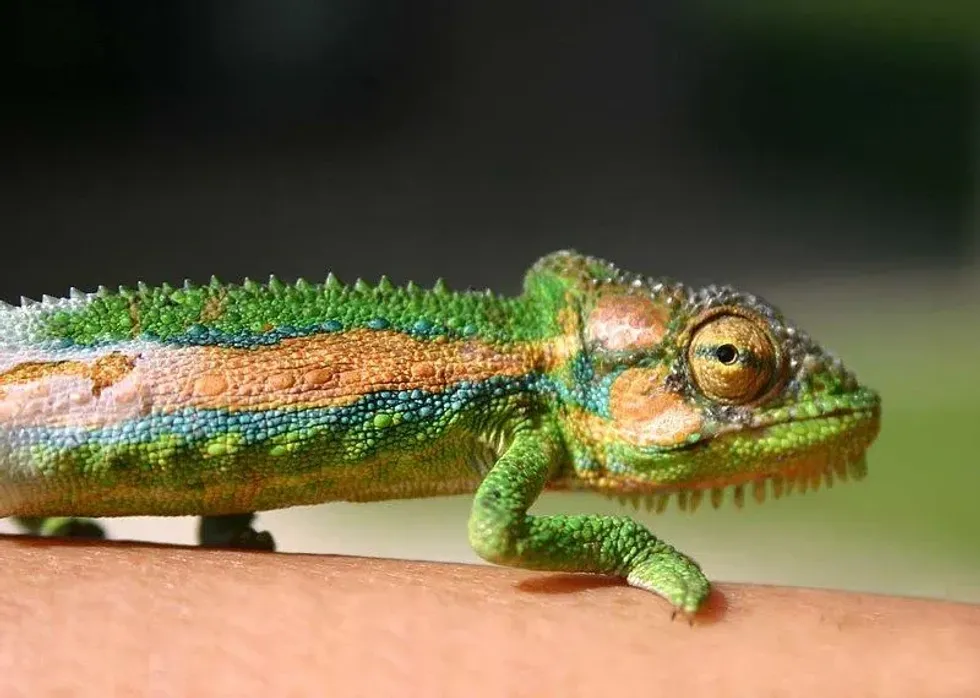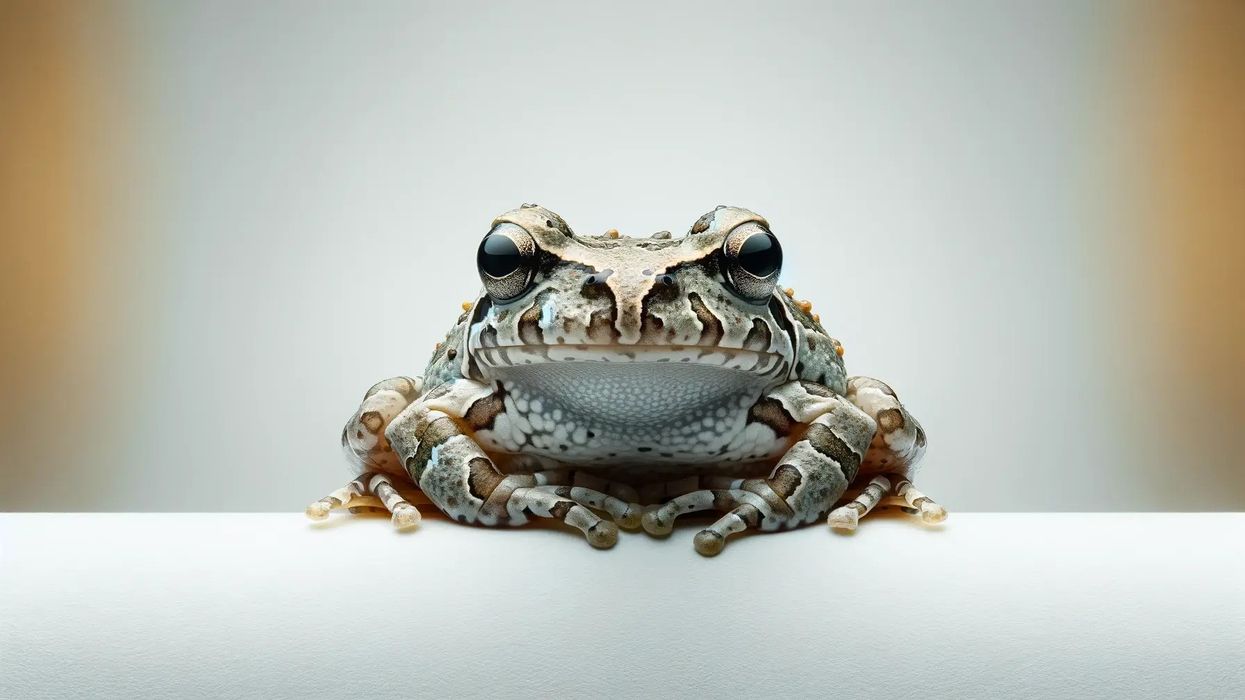Cape dwarf chameleon (Bradypodion pumilum) has always been a creature of utmost interest and fascination owing to its mind-blowing ability to camouflage or color change by simply taking the color of its surroundings or the surface it sits on.
Cape dwarf chameleon is a member of a family of six different types of chameleons and is generally found in the South African area known as the Western Cape, or more specifically, in and around the city of Cape Town. Cape dwarf chameleon, like other chameleons, uses its enormous tongue to catch insects to eat.
Cape dwarf chameleon (Bradypodion pumilum) is a cold-blooded animal and generally thrives in river valleys and low-lying vegetation.
However, an interesting fact about this species is that in habitats with dense vegetation, chameleons grow to be larger and more vibrant in color as compared to those living in the open. Keep reading about the Cape dwarf chameleon, also known as Bradypodion pumilum.
For more relatable content, check out these frilled lizard facts and thorny devil facts for kids.
Cape Dwarf Chameleon Interesting Facts
What type of animal is a Cape dwarf chameleon?
Cape dwarf chameleon scientifically known as Bradypodion pumilum is a type of chameleon, that is, a group of organisms belonging to the Old World lizards. The dwarf chameleon is a native inhabitant of South Africa, particularly along the region of Cape Town.
This species is known for its tongue size, which is sometimes as long as twice the body size.
What class of animal does a Cape dwarf chameleon belong to?
Cape dwarf chameleons, scientific name Bradypodion pumilum belong to class Reptilia; that is, a class of organisms that are categorized for their creeping and crawling mode of locomotion and for the dry cornified skin, epidermal scutes, and scutes that cover the body of these organisms.
How many Cape dwarf chameleons are there in the world?
There are no exact details about the total population of Cape dwarf chameleon in Cape Town, South Africa.
However as the species of these reptiles are categorized as Near Threatened by the IUCN Red List, it can be assumed that their numbers are declining and there is a risk of extinction, thus necessitating help from all quarters for their survival.
Where does a Cape dwarf chameleon live?
A Cape dwarf chameleon generally is observed to live in the fynbos biome comprising woods with plenty of vegetation and trees. This species is almost exclusively found in and around Cape Town, South Africa.
What is a Cape dwarf chameleon's habitat?
A Cape dwarf chameleon thrives in habitats wherein there are plenty of trees and low-lying shrubbery called fynbos habitat. Therefore, Cape dwarf chameleon habitat consists of dense vegetation areas and forest cover from aerial predators such as fiscal shrikes allows their bodies to adapt to grow bigger and brighter.
The color change that Cape dwarf chameleon goes through is entirely hormonal and involuntary.
Who do Cape dwarf chameleons live with?
Generally, members belonging to the species of Cape dwarf chameleon live in isolation. However, they interact with the other members of their species depending on their mood which these dwarf chameleons express by color changes.
How long does a Cape dwarf chameleon live?
There are no accurate details about Cape dwarf chameleon lifespan. However, in general, the average lifespan of these animals is short, ranging between 3-5 years.
How do they reproduce?
The reproductive cycle in these ovoviviparous females (organisms that directly give birth to their young ones, which originates from the eggs that hatch within the body of the female) begins with a small courtship ritual during which the male dwarf chameleon express its interactive mood and interest by the display of bright colors and quick twitching movement of their head.
However, if the potential female is disinterested, she switches to darker body shades, along with exhibiting a threatening position with their open mouth. Whereas in the case of mutual interest copulation takes place.
Following fertilization, females give rise to about 5-15 babies.
What is their conservation status?
According to the IUCN’s (International Union for Conservation of Nature) Red List, the Cape dwarf chameleon has been categorized and kept under the conservation status of Near Threatened species, owing to the small size of their population.
Cape Dwarf Chameleon Fun Facts
What do Cape dwarf chameleons look like?
A Cape dwarf chameleon head is a bit curved and comes in various colors.
Cape dwarf chameleons generally measure about 6 in (15 cm) in length and their tails are included in that length. A fact to be noted regarding Cape dwarf chameleons is that both male Cape dwarf chameleons, as well as female Cape dwarf chameleons, grow to be roughly the same size in the same habitat as the other.
Their colors are variable and change as per their will, and according to their surroundings.
Depending on whether it lives in dense vegetative areas, it can be extremely vibrant to look at or extremely dull in color if it lives in open areas with low-lying shrubbery. The young Cape dwarf chameleons simply look like scaled-down versions of the adults and nearly every chameleon differs in its bodily patterns.
The Cape dwarf chameleon uses its feet and limbs to walk and to grab onto twigs, leaves, and so on.

How cute are they?
Cape dwarf chameleons, more than cute, can be described as elegant and interesting to look at. The major charm of these reptiles is the fascinating display of color changes. They look extremely cute while licking raindrops or dew from the leaves.
How do they communicate?
The Cape dwarf chameleon makes use of its ability to change colors to not only communicate or speak with each other but also as a means of expressing their moods and emotions.
How big is a Cape dwarf chameleon?
The average length of Cape dwarf chameleons including the dimensions of their tail is about 5.9 in (15 cm). Cape dwarf chameleon size varies between males and females.
How fast can a Cape dwarf chameleon move?
There are no exact and specific details about the speed of Cape dwarf chameleon, however, they are known to be slow-moving reptiles.
How much does a Cape dwarf chameleon weigh?
A Cape dwarf chameleon adult weight is in ounces. It weighs roughly between 3-6 oz (85-170 gm).
What are the male and female names of the species?
There is no specific designation allocated to the members of Bradypodion pumilum species based on their sex. Generally, males are known as male Cape dwarf chameleons, while females are known as female Cape dwarf chameleons.
What would you call a baby Cape dwarf chameleon?
The offspring of Cape dwarf chameleon is referred to as a hatchling, neonate, or juvenile.
What do they eat?
Cape dwarf chameleons are carnivorous organisms, particularly insectivorous. They use their telescopic tongue to feed on small insects like caterpillars, sowbugs and termites, or some bird species.
Are they poisonous?
No, the Cape dwarf chameleon is not known to be poisonous.
Would they make a good pet?
No, the Cape dwarf chameleon would not make for a good pet. In fact, it is illegal to have these reptiles as pets. The prime reason for this is the fact that the population of Cape dwarf chameleon is declining rapidly, in fact, these reptiles are classified as a Near Threatened species by the IUCN.
Did you know...
Cape dwarf chameleons are sluggish reptiles. In fact, the genus name used in the binomial nomenclature of these Old world lizards, Bradypodion, is derived from the Greek word, which means slow foot.
The best way to attract chameleons to your garden is by covering the soil with a thick layer of compost, decaying leaves, and woodchips. This will attract various insects to your garden, and to feed on them, the chameleons will arrive.
What is the difference between a Cape dwarf chameleon and a regular chameleon?
A number of differences and similarities have been reported between a Cape dwarf chameleon and other chameleons. To begin with, regular chameleons are known as Mediterranean chameleons and this species is at least an inch larger than the Cape dwarf chameleon.
Moreover, the common chameleon sports stripes along its side whereas the Cape dwarf chameleon is generally of one single color, free of stripes.
Why do chameleons change color?
The most widely known reason for chameleons changing color is to blend in with their immediate environment as a defense mechanism from predators such as birds or snakes. However, this is not the sole reason chameleons change their colors.
They make use of their morphing abilities to communicate their moods and emotions between species of chameleons as well as with their immediate natives. Chameleons can also change colors as a means to regulate their body temperatures.
This morphing ability is achieved by their natural pigments which are stored within tiny sacs in their body which can be triggered by their nervous system based on their need at that moment.
Here at Kidadl, we have carefully created lots of interesting family-friendly animal facts for everyone to discover! For more relatable content, check out these marine iguana facts and sand lizard facts pages.
You can even occupy yourself at home by coloring in one of our free printable cape dwarf chameleon coloring pages.









